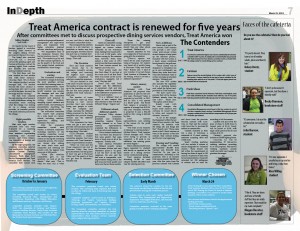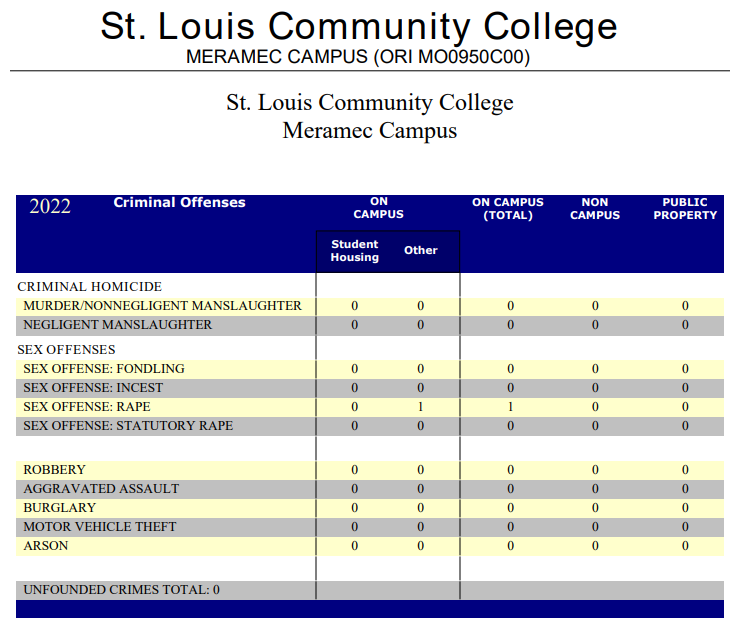Treat America ranked the highest out of scores submitted by the selection committee with 75 points. A subsidy not to exceed $96,000 was proposed with Treat America’s bid. Treat America currently received a $96,000 from the college under its current dining service contract.

Mike Zielger
– Staff Writer –
![]()
On March 24, the board of trustees passed a resolution awarding Treat America as the campus dining services provider for the next five years.
The board also awarded Coca-Cola Co. a five-year contract for pouring rights and Canteen a five-year contract for vending rights. Each contract also includes five one-year optional contract renewals.
“We [bid them out] this year because we had another year with Treat America,” Christina Hart, STLCC-Forest Park campus auxiliary services manager said, “We decided because the Coke contract is ending June, why don’t we bid out all of the items, the food, the beverage and the vending?”
The bids were collected through placing advertisements in local publications asking for submissions while outlining what the college was looking for in a dining services provider, as common practice with most contracts pursued by the college.
Eight possible vendors
Hart said eight vendors submitted bids and were evaluated by a screening committee consisting of three members representing purchasing and auxiliary services, and Carla Chance, vice chancellor of finance and business services.
Of the eight proposals, the screening committee selected four semifinalists. Those chosen include Canteen Vending, Consolidated Management Company, Fresh Ideas Food Service Management and Treat America Food Services. The committee then scored each vendor on its proposed financial, management and supervision plan, and experience with higher education, planned services, selections and pricing.
“We disqualified some of the companies because they had no locations close by,” Hart said. “We wanted to go by and see their normal operations, to see the quality of the food and how people looked, sanitation, sustainability, those things.”
Evaluation and scoring
The 16-member evaluation committee in charge of choosing the most qualified services included the screening team, six student representatives, three auxiliary service members, one faculty member, one campus life manager and one staff professional. The committee evaluated each proposal by visiting vendor facilities, sampling typical cafeteria and catered meals, and listening to presentations describing the services they would provide.
The evaluation committee then scored each proposal on a scale based on various criteria including selection, supervision, staffing and sanitation, Hart said.
After the evaluation committee scored each vendor, a selection committee including members of the screening committee scored the vendors again on the same criteria as during the screening committee process. The winner was chosen after adding the score totals from each committee and selecting the vendor with the highest total score out of 300 points.
“When [the selection committee] gets to the selection, we look at all the details,” Hart said. “This is what we read, this is what we saw, and this is what the evaluation committee thinks.”
Hart compared the selection process to a job interview. A candidate, or vendor, may look great on paper, but then come in late and wear a wrinkled shirt.
“People will promise lots of things,” Hart said.
The Decision
Hart said Treat America was chosen due to its experience currently serving the college and receiving the highest score among evaluations completed by selection committee members.
“We just decided to stay with what we knew because of the number of issues that come up in the transition as well as the fact that most people are satisfied with Treat America,” Hart said.
The number of issues that typically come up when choosing a new service provider, Hart said, include hiring new people to work with the company and college, learning the different billing processes for the three campuses that provide dining services and the different campus layouts.
“Our experience has been, when you get a new service provider, the transition takes the first year of just learning how to do everything,” Hart said.
STLCC-Meramec student Vincent Hayden, a student committee member, had some concerns with Treat America’s choice of presentation location.
“When we went and did [Treat America’s] site visit at Florissant Valley, they have good food there, but the quality of food you get at Florissant Valley isn’t the quality of food you get here at Meramec,” Hayden said.
Close call
Based on committee scoring documents, Fresh Ideas scored highest on various criteria submitted by the evaluation team, beating Treat America 85.2 to 81.6 out of 100 points. After further scoring by the selection team, however, Fresh Ideas earned a total score of 193.3 points from the three committees and Treat America earned the highest score with 216.6.
“Most people really did like Fresh Ideas. If you look at the scores you’ll see that Fresh Ideas won based on the survey evaluations, negligibly, but it won,” Hayden said.
Forest Park chef Todd Segreri said the differences in equipment, staff, and chef techniques could be attributed in the differences of quality and taste at each location.
“It is a different kind of aspect at each campus that each chef has to deal with those different things,” Segreri said.
Different school, different quality
Florissant Valley student government association president and evaluation committee member Donna Brandy listened in as Treat America representatives explained the differences in food served at each campus.
“We as students understand that, but there still should be that same quality, that same level of food even at all of the campuses,” Brandy said.
Treat America President Ed Holland recently visited the Meramec kitchen and said Meramec’s pizza is “as good, if not the best” of the three campuses. He also said the deli area is comparable, with improvement being seen in the grill area and food quality and taste over the last three months.
“From the catering standpoint, I get more positive emails from Meramec faculty than any other school combined,” Holland said.
Hayden admitted he was not a supporter of Treat America going into the evaluation.
“[Vince’s] opinion was based off his main experience being at Meramec. My opinion was based off of mostly being at Florissant Valley and Forest Park,” Brandy said. “I kind of now wonder, if we had chosen Treat America at Meramec for the testing, would it of been a different experience?”
Money, money, money
Included with Treat America’s bid proposal were projections of sales for the next five years. Florissant Valley is projected to lose $240 in 2012, and by 2016, it will operate at a $4,347 profit. The Forest Park campus is projected to operate at average loss $15,531 each year. Meramec, however, is projected to earn a $54,200 profit in 2012, rising to $69,300 by 2016.
Treat America representatives said catering is the reason for the profit disparities.
“The bulk of our business at Meramec is catering dollars,” Michael Harris, Treat America District manager, said. “When we’re trying to provide, as requested, a $3 meal in our cafeterias, our catering prices are much higher.”
Harris referenced a $3 lunch figure requested by students and faculty as reported in the results of a dining services survey conducted last spring.
Treat America included allocating $1,000 to each campus student life office each year for catering services.
New Additions
Harris said as part of the new contract, Treat America will provide a new touch screen point-of-sale system at each campus to help speed up the checkout process,. Included with the system is a touch screen nutritional kiosk placed by the grill area.
“Touch screens will be displayed so [students] can go in and nutritionally see before they order their food what the nutritional value is so they can make an educated decision,” Holland said.
The new POS system also includes the capability to use a declining balance card, called the Sprout card, provided by Treat America.
“We don’t know how popular that will be because students already have the One Card,” Harris said. “The option will be there.”
Brandy said with the new changes, she hopes Treat America will continue its recent efforts to listen and respond to students’ concerns.
“A lot of the changes that happened within the last three to four months with Treat America, for instance, with the cheap eats and things like that,” Brandy said. “Those came about so fast, I think, because we were in the process of the new contract, their contract ending, and the new one beginning.”
Pouring and Vending
The college will receive approximately $62,000 from Canteen and $261,450 from Coca-Cola Co. per year in commissions, according to bid proposals. This is an increase from approximately $40,000 per year, over five years from the previous contract with Canteen and down from the previous ten-year contract with Coca-Cola Co. Hart said the contract with Coca-Cola Co. provided $3 million in commissions.
Canteen included in their bid a plan to introduce a minimum of 13 snack vending machines accepting debit and credit cards.
Snack vending machines will also include a column of snacks designated as “balanced choices.” These choices will fall within the requirements of having less than or equal to 250 calories, 35 percent of daily total fat recommendations, 10 percent saturated fat, 350 milligrams of sodium and no trans fat, according to bid documents.
Canteen will also lower the price of chips to $1.00 from its current price of $1.10. Candy will be priced at $1.00, with large candy priced at $1.50, and cookies at $1.25.
Canteen’s proposal also includes a $20,000 signing bonus.
Coca-Cola Co. will be implementing 39 full-service vending machines according to its bid proposal. Full-service vending machines include credit and debit card readers to purchase beverages.










